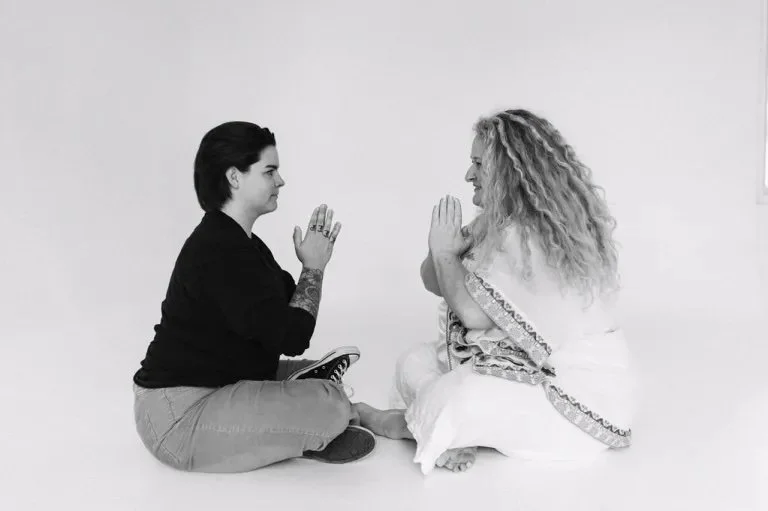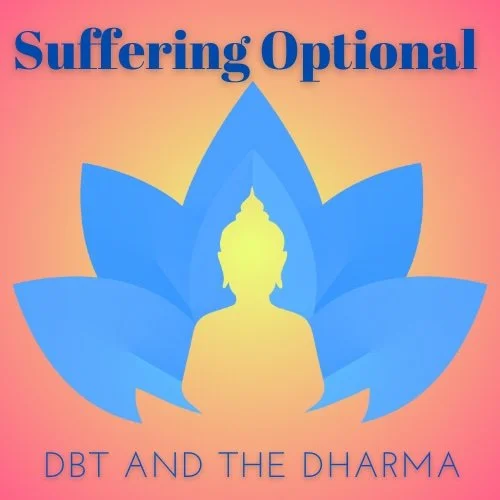Suffering Optional Episode 2: Meditation Myths Busted
Mindfulness Myths, Anchors, and the Power of Practice
In this episode of Suffering Optional, Diana and Maddie dive into the importance of mindfulness as a practice. Diana uses an analogy about learning to swim to highlight the challenges of starting out, while Maddie shares barracuda story from DBT for Life: Skills to transform the way you live to discuss common misconceptions. They explore the first foundation of mindfulness, touching on dharma, and emphasize that mindfulness can feel difficult at first but improves with practice.
The episode introduces the idea mindfulness isn’t limited to mindfulness of breath. Anything can be used as the focus of your attention—a mindfulness walk, or even focusing on your cat. They also discuss trauma-informed meditation, encouraging listeners to choose their own effective anchor for the week. For more resources and guided meditations, visit the website.
Takeaway: Mindfulness takes practice, and anything can be your anchor.
How to Listen
Episode 2: Mindfulness Myths Busted is available wherever you get your podcasts. Here are links to it on Spotify and Apple Podcasts.
Mindfulness Anchors
In mindfulness, an anchor is something you focus on to stay in the present moment. It is a focal point for training your attention.
Your anchor can be anything that feels grounding—a breath, a sound, or even the texture of something you’re touching. The important thing is to choose something to train your attention on, so that you can notice when your attention has strayed and gently bring your attention back to your anchor. For example, if you use your breath as an anchor, each time your mind drifts, gently refocus on the sensation of breathing in and out. If the hum of your air conditioner or the feeling of your feet on the ground feels more natural, let that be your anchor. Mindfulness isn’t about perfect focus; it’s about practicing the skill of returning to the present, again and again.
Your heartbeat can serve as a natural rhythm to focus on, bringing your attention inward. You might also notice the temperature around you—the warmth of a blanket or the coolness of the air on your skin can be grounding. A calming scent, like lavender or even fresh air, can be another powerful anchor. Tasting your food or drink and really focusing on the flavors can help anchor you in the present moment. Lastly, paying attention to light—whether it’s sunlight, the glow of a lamp, or the soft flicker of a candle—can gently draw you back to the here and now.
In this way, we train our attention to focus where we want it to focus. For instance, when you are at work and you want to focus on work, but intense emotions are pulling your attention to think about that fight with your mother. Mindfulness practice will help you select your work as your anchor and attend to the issues with your mother later.
Take a moment to consider what might be your anchor today. It could be something as simple as the feel of your hands resting in your lap.
Pali Translations (as promised)
In each episode, Maddie introduces important terms from Buddhism. These terms are the original words from Pali Sanskrit.
Sati Patana Sutra
The Satipatthana Sutta (often spelled Sati Patana Sutra) is a foundational Buddhist discourse that outlines the practice of mindfulness (sati). It’s one of the key teachings of the Buddha and serves as a guide for cultivating mindfulness through four areas of focus. These four foundations of mindfulness are:
Mindfulness of the body (kayanupassana) – This is about paying attention to your physical body. You can start by noticing your breath, your posture, how your body feels as you move or sit, and even your body’s sensations like warmth, tension, or pain. It’s a way to stay grounded in the present moment by tuning into what’s happening in your body right now.
Mindfulness of feelings (vedananupassana) – Here, you focus on the feelings or sensations that arise—whether something feels pleasant, unpleasant, or neutral. The goal is to notice these feelings without immediately reacting to them, helping you avoid being swept away by the highs and lows of emotions.
Mindfulness of mind (cittanupassana) – This foundation is about checking in with the state of your mind. Is it calm? Restless? Clear? Cloudy? You simply observe where your mind is at, noticing thoughts and mental activity without getting caught up in them.
Mindfulness of mental phenomena (dhammanupassana) – This involves recognizing the mental patterns and habits that come up, like desires, aversions, or other emotions. It’s about being aware of the mental forces shaping your thoughts and actions, so you can respond to them with wisdom instead of being controlled by them.
The Sutta explains how mindfulness in these four areas leads to a deep understanding of the nature of reality, helping to free oneself from suffering. It’s considered a core teaching in Theravada Buddhism and is the basis for many modern mindfulness practices, emphasizing clear awareness of what is happening in the present moment.






